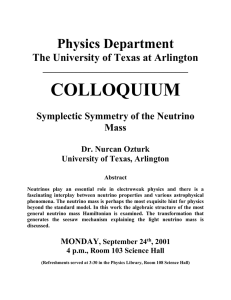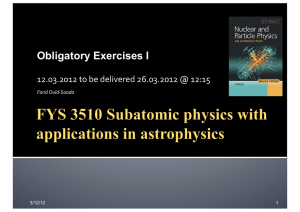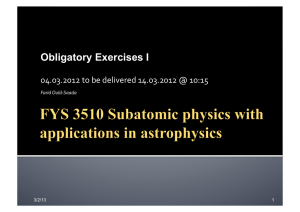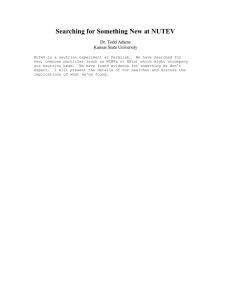Neutrino Mass Models: a road map
advertisement
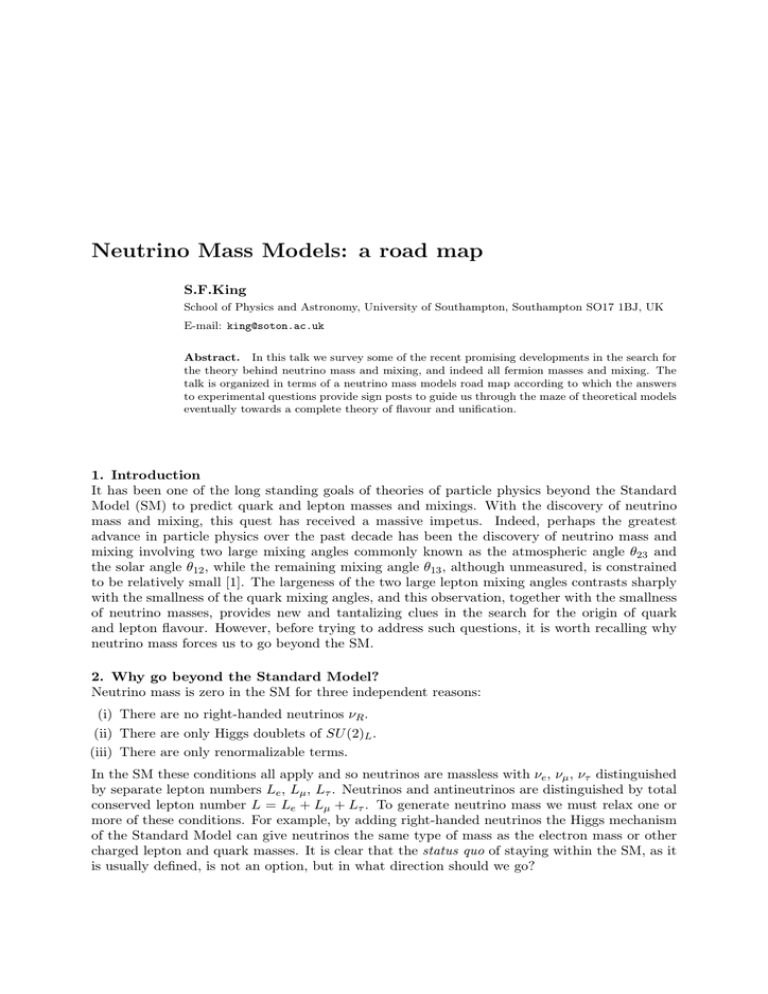
Neutrino Mass Models: a road map S.F.King School of Physics and Astronomy, University of Southampton, Southampton SO17 1BJ, UK E-mail: king@soton.ac.uk Abstract. In this talk we survey some of the recent promising developments in the search for the theory behind neutrino mass and mixing, and indeed all fermion masses and mixing. The talk is organized in terms of a neutrino mass models road map according to which the answers to experimental questions provide sign posts to guide us through the maze of theoretical models eventually towards a complete theory of flavour and unification. 1. Introduction It has been one of the long standing goals of theories of particle physics beyond the Standard Model (SM) to predict quark and lepton masses and mixings. With the discovery of neutrino mass and mixing, this quest has received a massive impetus. Indeed, perhaps the greatest advance in particle physics over the past decade has been the discovery of neutrino mass and mixing involving two large mixing angles commonly known as the atmospheric angle θ23 and the solar angle θ12 , while the remaining mixing angle θ13 , although unmeasured, is constrained to be relatively small [1]. The largeness of the two large lepton mixing angles contrasts sharply with the smallness of the quark mixing angles, and this observation, together with the smallness of neutrino masses, provides new and tantalizing clues in the search for the origin of quark and lepton flavour. However, before trying to address such questions, it is worth recalling why neutrino mass forces us to go beyond the SM. 2. Why go beyond the Standard Model? Neutrino mass is zero in the SM for three independent reasons: (i) There are no right-handed neutrinos νR . (ii) There are only Higgs doublets of SU (2)L . (iii) There are only renormalizable terms. In the SM these conditions all apply and so neutrinos are massless with νe , νµ , ντ distinguished by separate lepton numbers Le , Lµ , Lτ . Neutrinos and antineutrinos are distinguished by total conserved lepton number L = Le + Lµ + Lτ . To generate neutrino mass we must relax one or more of these conditions. For example, by adding right-handed neutrinos the Higgs mechanism of the Standard Model can give neutrinos the same type of mass as the electron mass or other charged lepton and quark masses. It is clear that the status quo of staying within the SM, as it is usually defined, is not an option, but in what direction should we go? 3. A road map This talk will be organized according to the road map in Fig.1. Such a road map is clearly not unique (everyone can come up with her or his personal road map). The road map in Fig.1 contains key experimental questions (in blue) which serve as signposts along the way, leading in particular theoretical directions, starting from the top left hand corner with the question “LSND True or False?” Figure 1. Neutrino mass models roadmap. 4. LSND True or False? As discussed in [2], the results from MiniBOONE do not support the LSND result, but are consistent with the three active neutrino oscillation paradigm. If LSND were correct then this could imply either sterile neutrinos and/or CPT violation, or something more exotic. For the remainder of this talk we shall assume that LSND is false, and focus on models without sterile neutrinos. Sterile neutrinos were discussed in this conference in [3]. 5. Dirac or Majorana? Majorana neutrino masses are of the form mνLL νL νLc where νL is a left-handed neutrino field and νLc is the CP conjugate of a left-handed neutrino field, in other words a right-handed antineutrino field. Such Majorana masses are possible since both the neutrino and the antineutrino are electrically neutral. Such Majorana neutrino masses violate total lepton number L conservation, so the neutrino is equal to its own antiparticle. If we introduce right-handed neutrino fields then there are two sorts of additional neutrino mass terms that are possible. There are additional ν ν ν c . In addition there are Dirac masses of the form Majorana masses of the form MRR R R ν mLR νL νR . Such Dirac mass terms conserve total lepton number L, but violate separate lepton numbers Le , Lµ , Lτ . The question of “Dirac or Majorana?” is a key experimental question which could be decided by the experiments which measure neutrino masses directly [4]. 6. What if Neutrinos are Dirac? Introducing right-handed neutrinos νR into the SM (with zero Majorana mass) we can generate a Dirac neutrino mass from a coupling to the Higgs: λν < H > νL νR ≡ mνLR νL νR , where < H >≈ 175 GeV is the Higgs vacuum expectation value (VEV). A physical neutrino mass of mνLR ≈ 0.2 eV implies λν ≈ 10−12 . The question is why are such neutrino Yukawa couplings so small, even compared to the charged fermion Yukawa couplings? One possibility for small Dirac masses comes from the idea of extra dimensions motivated by theoretical attempts to extend the Standard Model to include gravity . For the case of “flat” extra dimensions, “compactified” on circles of small radius R so that they are not normally observable, it has been suggested that right-handed neutrinos (but not the rest of the Standard Model particles) experience one or more of these extra dimensions [5]. For example, for one extra dimension the right-handed neutrino wavefunction spreads out over the extra dimension R, leading to a suppressed Higgs interaction with the left-handed neutrino. The Dirac neutrino mass is therefore suppressed relative to the electron mass, and may be estimated M as: mνLR ∼ MPstring me where MP lanck ∼ 1019 GeV /c2 , and Mstring is the string scale. Clearly lanck low string scales, below the Planck scale, can lead to suppressed Dirac neutrino masses. Similar suppressions can be achieved with anisotropic compactifications [7]. For the case of “warped” extra dimensions things are more complicated/interesting [8]. Typically there are two branes, a “Planck brane” and a “TeV brane”, with all the fermions and the Higgs in the “bulk” and having different “wavefunctions” which are more or less strongly peaked on the TeV brane. The strength of the Yukawa coupling to the Higgs is determined by the overlap of a particular fermion wavefunction with the Higgs wavefunction, leading to exponentially suppressed Dirac masses. For example the Higgs and top quark wavefunctions are both strongly peaked on the TeV brane, leading to a large top quark mass, while the neutrino wavefunctions will be strongly peaked on the Planck brane leading to exponentialy suppressed Dirac masses. 7. What if Neutrinos are Majorana? We have already remarked that neutrinos, being electrically neutral, allow the possibility of Majorana neutrino masses. However such masses are forbidden in the SM since neutrinos form part of a lepton doublet L, and the Higgs field also forms a doublet H, and SU (2)L × U (1)Y gauge invariance forbids a Yukawa interaction like HLL. So, if we want to obtain Majorana masses, we must go beyond the SM. One possibility is to introduce Higgs triplets ∆ such that a Yukawa interaction like ∆LL is allowed. However the limit from the SM ρ parameter implies that the Higgs triplet should have a VEV < ∆ >< 8 GeV. One big advantage is that the Higgs triplets may be discovered at the LHC and so this mechanism of neutrino mass generation is directly testable [9]. Another possibility, originally suggested by Weinberg, is that neutrino Majorana masses originate from operators HHLL involving two Higgs doublets and two lepton doublets, which, being higher order, must be suppressed by some large mass scale(s) M . When the Higgs doublets get their VEVs Majorana neutrino masses result: mνLL = λν < H >2 /M . This is nice because the large Higgs VEV < H >≈ 175 GeV can lead to small neutrino masses providing that the mass scale M is high enough. E.g. if M is equal to the GUT scale 1.75.1016 GeV then mνLL = λν 1.75.10−3 eV. To obtain larger neutrino masses we need to reduce M below the GUT scale (since we cannot make λν too large otherwise it becomes non-perturbative). If the coupling λν is very small (for some reason) then M could even be lowered to the TeV scale and the see-saw scale could be probed at the LHC, however the see-saw mechanism then no longer solves the problem of the smallness of neutrino masses. Typically in physics whenever we see a large mass scale M associated with a nonrenormalizable operator we tend to associate it with tree level exchange of some heavy particle or particles of mass M in order to make the high energy theory renormalizable once again. This idea leads directly to the see-saw mechanism where the exchanged particles can either couple in the s-channel to HL, in which case they must be either fermionic singlets (right-handed neutrinos) or fermionic triplets, or they can couple in the t-channel to LL and HH, in which case they must be scalar triplets. These three possibilities have been called the type I, III and II see-saw mechanisms, respectively. There are other ways to generate Majorana neutrino masses which lie outside of the above discussion. One possibility is to introduce additional Higgs singlets and triplets in such a way as to allow neutrino Majorana masses to be generated at either one [10] or two [11] loops. Another possibility is within the framework of R-parity violating Supersymmetry in which the sneutrinos ν̃ get small VEVs inducing a mixing between neutrinos and neutralinos χ leading to Majorana neutrino masses mLL ≈< ν̃ >2 /Mχ , where for example < ν̃ >≈ MeV, Mχ ≈ TeV leads to mLL ≈ eV. A viable spectrum of neutrino masses and mixings can be achieved at the one loop level [12]. 8. Normal or Inverted? If the mass ordering is inverted (as defined for example in [13]) then this may indicate a new symmetry such as Le − Lµ − Lτ [14] or a U (1) family symmetry [15]. However let us assume that the hierarchy is normal and proceed down the road map to the next experimental question. 9. Very precise tri-bimaximal mixing? It is a striking fact that current data on lepton mixing is consistent with the so-called tribimaximal (TB) mixing pattern [16], q UT B = 2 3 − √16 √1 6 √1 3 √1 3 − √13 0 √1 2 √1 2 PM aj , (1) where PM aj is the diagonal phase matrix involving the two observable Majorana phases. However there is no convincing reason to expect exact TB mixing, and in general we expect deviations. These deviations can be parametrized by three parameters r, s, a defined as [17]: sin θ13 = √r2 , sin θ12 = √13 (1 + s), sin θ23 = √12 (1 + a). Global fits of the conventional mixing angles [18] can be translated into the 2σ ranges 1 0 < r < 0.28, −0.10 < s < 0.02, −0.12 < a < 0.12. Very precise TB mixing would correspond to r, |s|, |a| ¿ 1, and TB mixing would demand an explanation, while if r, s, a are close to their current 2σ bounds, then TB mixing would only be realized approximately and could be just a coincidence. But the question is how small would r, |s|, |a| have to be in order for TB mixing not to be a coincidence? This question has been addressed in [19] where it is argued that the crucial parameter is Ue3 or r, and that if this parameter is much smaller than about 0.1 then it would be hard to argue that TB mixing is accidental. On the other hand if r > 0.1 then perhaps we should not regard the angle θ13 as being particularly small, and one possibility is that all the lepton mixing angles are chosen at random, for example as in “Anarchy” [20]. 10. Family Symmetry? Assuming that TB mixing is very precise and is not an accident, it could be interpreted as a signal of an underlying family symmetry. Indeed I am unaware of any viable alternative at present. To 1 Note that r must be positive definite, while s, a can take either sign. Indeed there is a preference for s to be negative. understand the emergence of a family symmetry, let us expand the neutrino mass matrix in the diagonal charged lepton basis, assuming exact TB mixing, as mνLL = UT B diag(m1 , m2 , m3 )UTTB leading to (absorbing the Majorana phases in mi ): mνLL = m3 m2 m1 Φ3 ΦT3 + Φ2 ΦT2 + Φ1 ΦT1 2 3 6 (2) where ΦT3 = (0, 1, −1), ΦT2 = (1, 1, 1), ΦT1 = (2, −1, 1) and mi are the physical neutrino masses. This shows that the neutrino mass matrix corresponding to TB mixing may be constructed from the very simple orthogonal column vectors Φi , whose simplicity motivates an underlying non-Abelian family symmetry involving all three families. The idea is that Φi are promoted to new Higgs fields called “flavons” whose VEVs break the family symmetry, with the particular vacuum alignments as above. Such vacuum alignments can more readily be achieved if the nonAbelian family symmetry is a discrete symmetry containing a permutation symmetry capable of leading to < ΦT2 >∝ (1, 1, 1) [21]. A minimal choice of such family symmetry seems to be A4 [22] which only involves the flavon < ΦT2 >∝ (1, 1, 1) together with a further flavon < ΦT0 >∝ (0, 0, 1). Such minimal A4 models lead to neutrino mass sum rules between the three masses mi , resulting in/from a simplified mass matrix in Eq.2. A4 may result from 6D orbifold models [23]. It is possible to derive the TB form of the neutrino mass matrix in Eq.2 from the seesaw mechanism in a very elegant way using the idea of constrained sequential dominance ν = (CSD)[24] as follows. In the diagonal right-handed neutrino mass basis we may write MRR ν diag(MA , MB , MC ) and the Dirac mass matrix as mLR = (A, B, C) where A, B, C are three ν )−1 (mν )T gives column vectors. Then the see-saw formula mνLL = mνLR (MRR LR mνLL = BB T CC T AAT + + . MA MB MC (3) By comparing Eq.3 to the TB form in Eq.2 it is clear that TB mixing will be achieved if A ∝ Φ3 , B ∝ Φ2 , C ∝ Φ1 , with each of m3,2,1 originating from a particular right-handed neutrino of mass MA,B,C , respectively [24]. If m1 ¿ m2 < m3 then the precise form of C becomes irrelevant, and the CSD mechanism has been applied in this case to models based on the family symmetries SO(3) [24, 25] and SU (3) [26], and their discrete subgroups [27]. 11. Hierarchical or Degenerate? This key experimental question may be decided by the same experiments as will also determine the nature of neutrino mass (Dirac or Majorana) [4]. Although not a theorem, it seems that a hierarchical spectrum could indicate a type I see-saw mechanism, while a (quasi) degenerate spectrum could imply a type II see-saw mechanism. It is possible that a type II see-saw mechanism could naturally explain the degenerate mass scale with the degeneracy enforced by an SO(3) family symmetry, while the type I see-saw part could be responsible for the small neutrino mass splittings and the (TB) mixing [28]. 12. GUTs and/or Strings? Finally we have reached the end of the road map, with the possibility of an all-encompassing unified theory of flavour based on GUTs and/or strings. Such theories could also include a family symmetry in order to account for the TB mixing. There are many possibilities for the choice of family symmetry and GUT symmetry. Examples include the Pati-Salam gauge group SU (4)P S × SU (2)L × SU (2)R in combination with SU (3) [26], SO(3) [24, 25], A4 [29] or ∆27 [30]. Other examples are based on SU (5) GUTs in combination with A4 [31] or T 0 [32]. In typical Family Symmetry ⊗ GUT models the origin of the quark mixing angles derives predominantly from the down quark sector, which in turn is closely related to the charged lepton sector. In order to reconcile the down quark and charged lepton masses, simple ansatze, such as the Georgi-Jarlskog hypothesis [33], lead to very simple approximate expectations for the e ≈ λ/3, θ e ≈ λ2 , θ e ≈ λ3 , where λ ≈ 0.22 is the charged lepton mixing angles such as θ12 23 13 Wolfenstein parameter from the quark mixing matrix. If the family symmetry enforces accurate e ≈ λ/3 charged lepton corrections will cause deviations TB mixing in the neutrino sector, then θ12 from TB mixing in the physical lepton mixing angles, and lead to a sum rule relation [24, 34, 35], which can be conveniently expressed as [17] s ≈ r cos δ where r ≈ λ/3 and δ is the observable CP violating oscillation phase, with RG corrections of less than one degree [36]. Such sum rules can be tested in future high precision neutrino oscillation experiments [37]. 13. Conclusion Neutrino mass and mixing clearly requires new physics beyond the SM, but in which direction should we go? There are many roads for model building, but we have seen that answers to key experimental questions will provide the sign posts en route to a unified theory of flavour. References [1] [2] [3] [4] [5] [6] R. Zukanovitch-Funchal, these proceedings. S. Brice, these proceedings. M. Shaposhnikov, these proceedings. B. Kayser; G. Drexlin; G. Gratta; R. Flack; C. Cattadori; C. Brofferio; M. Chen; T. Noble; these proceedings. I. Antoniadis, arXiv:hep-ph/0512182. N. Arkani-Hamed, S. Dimopoulos, G. R. Dvali and J. March-Russell, Phys. Rev. D 65 (2002) 024032 [arXiv:hep-ph/9811448]. [7] S. Antusch, O. J. Eyton-Williams and S. F. King, JHEP 0508 (2005) 103 [arXiv:hep-ph/0505140]. [8] For an overview with references see e.g. S. J. Huber, arXiv:hep-ph/0211056. [9] P. Fileviez Perez, T. Han, G. y. Huang, T. Li and K. Wang, Phys. Rev. D 78 (2008) 015018 [arXiv:0805.3536 [hep-ph]]. [10] A. Zee, Phys. Lett. B 93 (1980) 389 [Erratum-ibid. B 95 (1980) 461]. [11] K. S. Babu, Phys. Lett. B 203 (1988) 132. [12] See for example: M. Hirsch, M. A. Diaz, W. Porod, J. C. Romao and J. W. F. Valle, Phys. Rev. D 62 (2000) 113008 [Erratum-ibid. D 65 (2002) 119901] [arXiv:hep-ph/0004115]. [13] A. Smirnov, these proceedings. [14] S. T. Petcov, Phys. Lett. B 110 (1982) 245. [15] S. F. King and N. N. Singh, Nucl. Phys. B 596 (2001) 81 [arXiv:hep-ph/0007243]. [16] P. F. Harrison, D. H. Perkins and W. G. Scott, Phys. Lett. B 530 (2002) 167 [arXiv:hep-ph/0202074]. [17] S. F. King, Phys. Lett. B 659 (2008) 244 [arXiv:0710.0530 [hep-ph]]. [18] T. Schwetz, M. Tortola and J. W. F. Valle, arXiv:0808.2016 [hep-ph]. [19] C. H. Albright and W. Rodejohann, Phys. Lett. B 665 (2008) 378 [arXiv:0804.4581 [hep-ph]]. [20] L. J. Hall, H. Murayama and N. Weiner, Phys. Rev. Lett. 84 (2000) 2572 [arXiv:hep-ph/9911341]. [21] G. Altarelli and F. Feruglio, Nucl. Phys. B 720 (2005) 64 [arXiv:hep-ph/0504165]. [22] E. Ma and G. Rajasekaran, Phys. Rev. D 64 (2001) 113012 [arXiv:hep-ph/0106291]. [23] G. Altarelli, F. Feruglio and Y. Lin, Nucl. Phys. B 775 (2007) 31 [arXiv:hep-ph/0610165]. [24] S. F. King, JHEP 0508 (2005) 105 [arXiv:hep-ph/0506297]. [25] S. F. King and M. Malinsky, JHEP 0611 (2006) 071 [arXiv:hep-ph/0608021]. [26] I. de Medeiros Varzielas and G. G. Ross, Nucl. Phys. B 733 (2006) 31 [arXiv:hep-ph/0507176]. [27] I. de Medeiros Varzielas, S. F. King and G. G. Ross, Phys. Lett. B 644 (2007) 153 [arXiv:hep-ph/0512313]. [28] S. Antusch and S. F. King, Nucl. Phys. B 705 (2005) 239 [arXiv:hep-ph/0402121]. [29] S. F. King and M. Malinsky, Phys. Lett. B 645 (2007) 351 [arXiv:hep-ph/0610250]. [30] I. de Medeiros Varzielas, S. F. King and G. G. Ross, Phys. Lett. B 648 (2007) 201 [arXiv:hep-ph/0607045]. [31] G. Altarelli, F. Feruglio and C. Hagedorn, JHEP 0803 (2008) 052 [arXiv:0802.0090 [hep-ph]]. [32] M. C. Chen and K. T. Mahanthappa, Phys. Lett. B 652 (2007) 34 [arXiv:0705.0714 [hep-ph]]. [33] H. Georgi and C. Jarlskog, Phys. Lett. B 86 (1979) 297. [34] I. Masina, Phys. Lett. B 633 (2006) 134 [arXiv:hep-ph/0508031]; [35] S. Antusch and S. F. King, Phys. Lett. B 631 (2005) 42 [arXiv:hep-ph/0508044]; [36] S. Boudjemaa and S. F. King, arXiv:0808.2782 [hep-ph]. [37] S. Antusch, P. Huber, S. F. King and T. Schwetz, JHEP 0704 (2007) 060 [arXiv:hep-ph/0702286].
